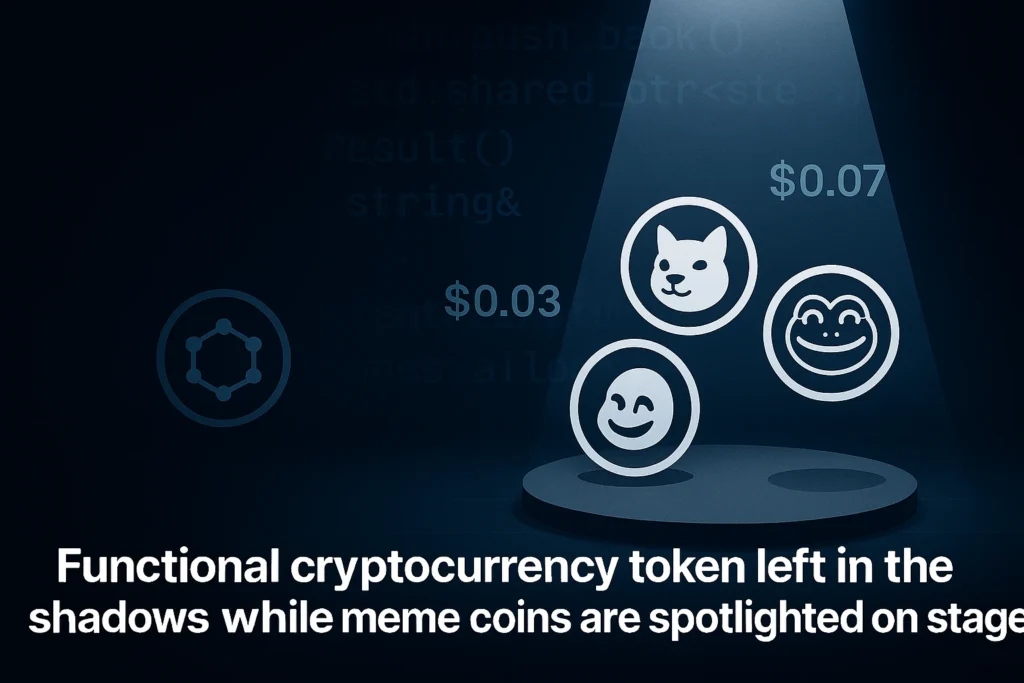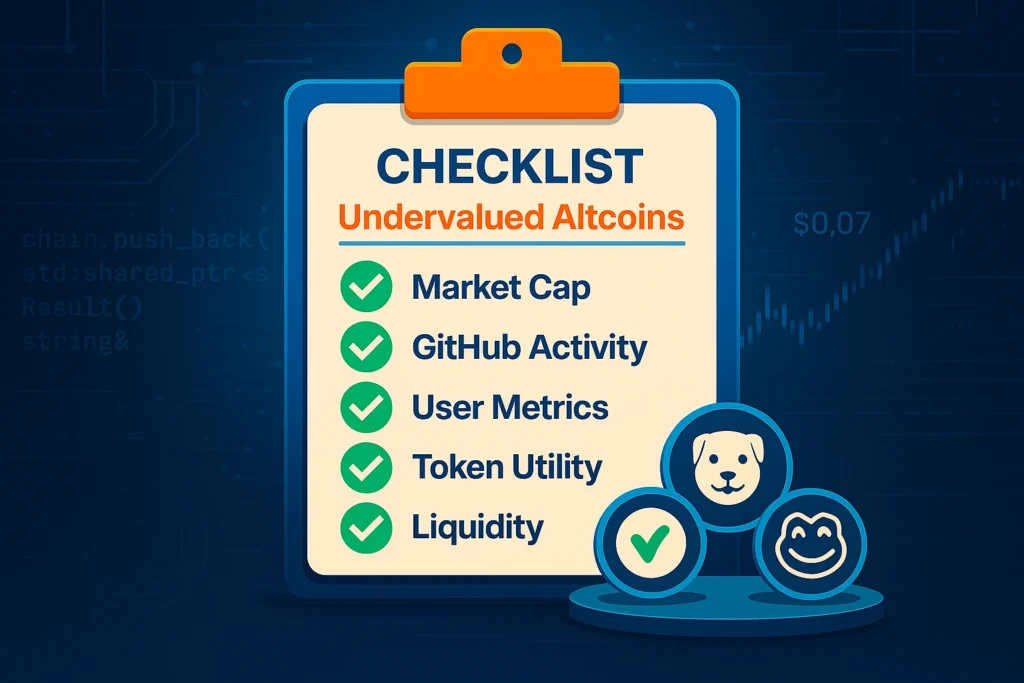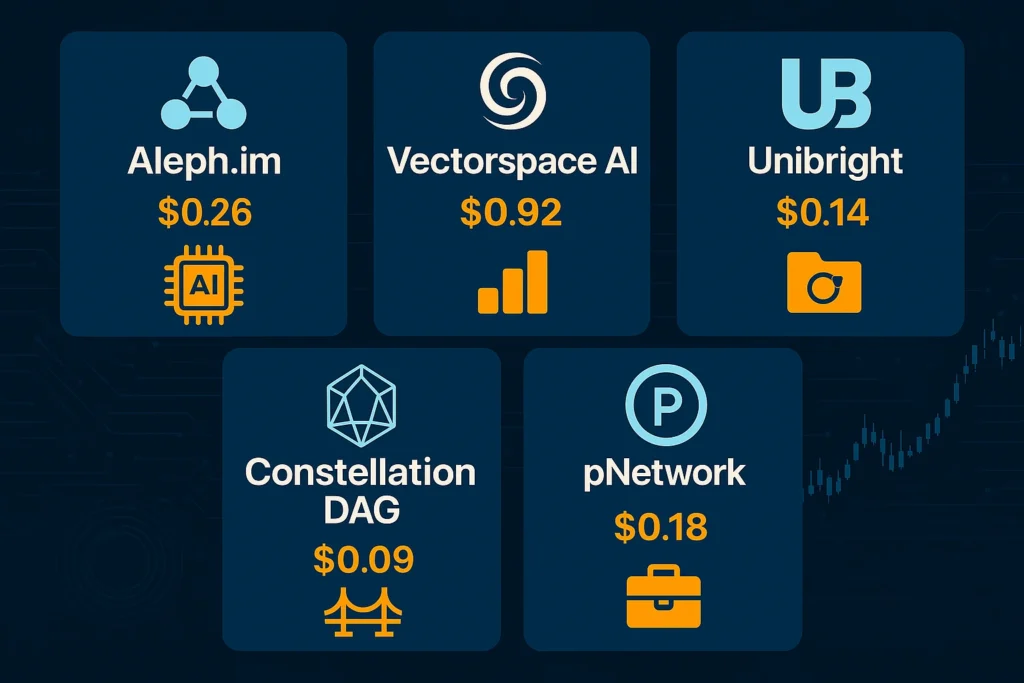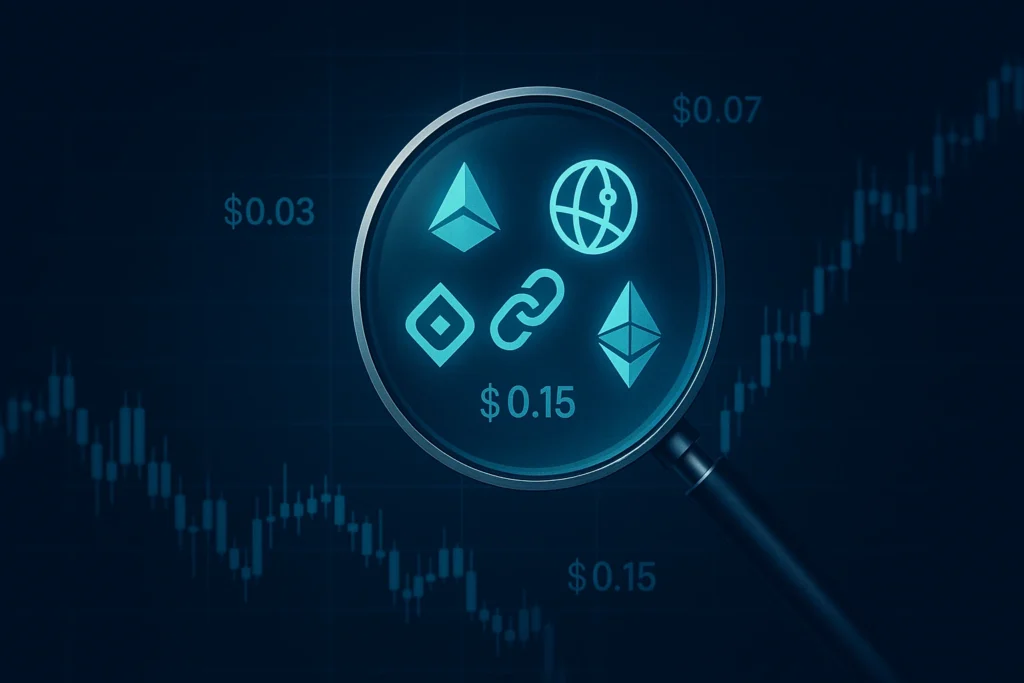The Real Reason Some Altcoins Stay Undervalued
If you have been watching the altcoin space lately, you’ve probably noticed something odd: some of the most active, functional, and real-world-use tokens are trading under $1, and they have been stuck there for months. Even more puzzling? A lot of them have market caps below $50 million, despite having GitHub commits, working apps, and actual user bases.
So why are these “undervalued altcoins under $1” not getting the attention they deserve?
The truth is, a market that is obsessed with memecoins and macro narratives, real utility often gets buried under noise. Crypto tokens that power infrastructure, enable payment layers, or link smart contracts to physical systems just don’t trend on Twitter even if they’re shipping code and building tools people use daily.
This post doesn’t list coins that are just “cheap.” We are not here to collect microcaps for the sake of it. Instead, we have filtered dozens of undervalued altcoins under $1 using five strict criteria: market cap, token utility, development activity, usage data, and liquidity risks.
The result? A curated shortlist of five undervalued crypto tokens under $1, each backed by a product, not just hope.
Let’s start with why some of these coins stay cheap in the first place.

Why Undervalued Altcoins under $1 Stay Cheap (Even When They Should not)
A lot of investors assume that if undervalued altcoins under $1 has a utility in the real world, consistent development, and a working product, they should naturally rise in value. In reality, the crypto market usually doesn’t work that way.
Here’s why:
Low Visibility, No Narrative
Many undervalued altcoins under $1 simply do not have the capital and resources for marketing. The reason is that these undervalued coins have no meme potential, no celebrity endorsements, and no speculative excitement. This means they are not gaining strong market attention, even if they are making steady progress behind the scenes.
Case in point: Ocean Protocol spent years building decentralized data marketplaces with real partnerships, but it remained unheard of for most retail traders.
High Supply, Slow Unlocks
An Altcoin can look “cheap” at a price of $0.04, but this price does not tell the whole story without taking the supply context into consideration. Suppose the project has 10 billion tokens with only 15% in circulation. In that case, future unlocks can suppress price growth for years, especially if the altcoin lacks strong sinks or revenue streams to absorb emissions.
Sources like Messari and Token Unlocks help surface these risks before they become portfolio pain points.
Niche Utility Doesn’t Always Scale
Some of these altcoins solve highly specific problems which involves invoice payments, decentralized storage, chain interoperability, etc. Are they Useful? Definitely. What about their mass adoption? Not guaranteed. That mismatch can keep valuations low, even if the token works.
No Speculation Flywheel
Unlike memecoins or L1 ecosystems with built-in hype loops, many undervalued altcoins lack the “flywheel effect” where “user adoption” leads to “token demand,” which takes it to “price rise,” which finally leads to “more users”. Without that loop, price often lags fundamentals.
Post-Hype Burnout
Some projects did have their moment. They pumped during 2021 and got listed on exchanges. They faded as soon as the market cycle cooled. But a few kept building, and that is exactly where hidden value lies. Not in the speculation, but in the rebuild.
As Token Terminal shows, revenue-generating dApps don’t always have strong token prices, but they do have survival odds.

Methodology – How We Identified These Undervalued Altcoins Under $1
There’s no shortage of “Top 10 Altcoins” posts that recycle the same names usually the ones trending on X (Twitter) or with recent Binance listings. That’s not what we did here.
We started with a simple goal to surface real altcoins under $1 that are genuinely undervalued, based on their product traction, development signals, and overlooked fundamentals rather then on social media attention.
Here’s exactly how we filtered them:
Firstly, The Market Cap Must Be Under $50M
We specifically targeted micro-cap altcoins trading under $1 with a fully diluted valuation (FDV) and market cap below $50M. The source of these undervalued altcoins under $1 were CoinGecko and CoinMarketCap. This ensured we were looking at early-stage projects with real upside but also real risk at the same time.
Secondly, Ongoing GitHub Development
Each coin had to show signs of active development within the last 90 days. Which was varified through their public GitHub repos. We disregarded any project that looked dormant, forked without direction, or was clearly abandoned.
Cross-checked via GitHub commit histories and Token Terminal’s Dev Activity Tracker.
Thirdly, Actual User Interaction (DAU + Wallet Activity)
We reviewed DappRadar, Footprint Analytics, and project-specific dashboards to check for real user activity, including unique wallets, transactions, and protocol usage. Thus a coin with a flashy whitepaper but no on-chain usage didn’t make the cut.
DAU metrics from DappRadar and Token Terminal
Fourthly, No Major Exchange Listing Yet
Altcoins already listed on Binance, Coinbase, or OKX were filtered out. Why? Because we belive that the biggest upside often exists before mainstream discovery. Every coin we picked is either on Tier-2 exchanges or still decentralized only.
Finally, Real-World Use Case or Infrastructure Role
Each coin had to do something. That sounds basic, but you’d be surprised how many tokens exist solely for staking or governance fluff. We selected coins with clear, functional roles in storage, payments, data indexing, commerce, or infrastructure.
These filters helped us reduce a longlist of 60+ sub-$1 altcoins down to just five we feel confident presenting as truly undervalued. They may not all moon tomorrow, but they’re not momentum plays. They’re infrastructure picks. Quiet builders. And sometimes, that’s where the real opportunity lies.

Coin-by-Coin Reviews of Undervalued Altcoins Under $1
These are not speculative meme coins. Rather, they are undervalued altcoins under $1 quietly building real infrastructure, with most investors too distracted to notice. We have evaluated each of them based on their on-chain activity, developer traction, use case clarity, and market conditions. Here is the list.
1. Aleph.im ($ALEPH)
You’d be surprised how often Aleph.im shows up under the hood. It’s quietly supporting cloud indexing and decentralized storage for dApps across Solana, Ethereum, and Avalanche, but never gets the same attention as the chains it helps scale. And that’s a big reason it’s overlooked.
Despite partnerships with Ubisoft and a few top-tier Layer 1s, its token remains well below $0.15 with a market cap under $35, almost laughable given its real-world use.
The devs are still active (latest GitHub activity in June 2025), and it’s integrated into protocols that move real volume daily. Yet crypto Twitter barely whispers about it.
📎 GitHub Activity | CoinGecko Stats
2. Vectorspace AI ($VXV)
Here’s one that flies entirely under the radar. Vectorspace AI isn’t chasing narratives; it’s quietly refining machine learning models by feeding them smarter data relationships.
It’s the kind of token that doesn’t belong in a meme thread but does show up in academic research papers and enterprise NLP projects.
In July 2025, it’s still trading under $0.20 with less than $25M in market cap. But behind the scenes, there’s sustained code shipping, a tight-knit dev team, and a utility that most retail users simply don’t understand.
3.Unibright ($UBT)
Unibright feels like an old-school startup that refused to pivot just to catch the latest trend. Their core platform still focuses on making smart contracts accessible to enterprise users, no Solidity required.
They’re a founding contributor to the Baseline Protocol, a collaboration that includes ConsenSys, EY, and Microsoft. Despite this, $UBT trades under $0.05 with a $14M cap, while other less-proven L2 tokens trade 10x higher.
For long-term thinkers, especially those eyeing enterprise blockchain adoption, UBT offers something rare: non-hype-based use cases with zero retail buzz.
📎 Baseline GitHub | UBT Stats
3.Constellation Network ($DAG)
This one feels like it belongs in a Defense Tech portfolio rather than your average DeFi stack.
Constellation is building a protocol for secure, scalable data transmission, and yes, they’ve actually signed contracts with the U.S. Air Force. That alone sets it apart from 99% of sub-$0.03 coins.
Their technology isn’t just promising, it’s in active deployment. GitHub shows biweekly commits, and documentation on HGTP (Hypergraph Transfer Protocol) is publicly available.
Yet, the crypto token languishes under $0.03 with a cap just shy of $45M.
📎 Constellation Site | Air Force Partnership
4. pNetwork ($PNT)
Everyone talks about bridging, but hardly anyone mentions pNetwork.
It’s been quietly running the pTokens infrastructure for years, allowing Bitcoin to be wrapped and used across Ethereum, EOS, and BNB Chain. With recent upgrades bringing Arbitrum and Polygon into the mix, this is a battle-tested bridge layer that doesn’t get the spotlight.
It’s not flashy. But the tech works. And while its price sits under $0.10, the team has kept pace with multi-chain developments better than half the “bridge wars” projects from 2021.
📎 pNetwork Blog | pTokens GitHub
Why Most Undervalued Altcoins Under $1 Stay That Way
We know what the deal is: you see a cent coin with a market cap of $13M and you think, What could this be, the next Solana?
However, most of the times it is not. And just in case you are thinking what is the reason it is sometimes not a bad ideas it is a bad structure.
Consider take token-product alignment. Many groups construct actual platforms. But the token? It just sits there. The app can be used, you can stake the assets, heck you can even transfer funds, but you never have to own the coin. That disconnect kills value accrual. No one wants to hold something that is not even required to use the product. Years ago, Vitalik Buterin put his finger under this when describing his analysis of governance vs. utility.
Then there’s liquidity. Of course, you can buy a small position on a Tier-3 exchange. But when you try to exit? Slippage is 30%. No volume. You’re stuck. Not rugged, just illiquid. We call those “soft rugs.”
Emissions don’t help. Altcoins that release too quickly lose momentum, even the good ones. You may fall in love with the project, yet as long as new coins are being issued to the market on a weekly basis, we are staring at a price bleed. You’ll find this buried in vesting schedules on TokenUnlocks or whitepapers no one reads.
And let’s not forget the ghost teams. A GitHub repo untouched in last six months, a Discord server filled with bots, and a blog last updated in 2022, it’s all too common. Even with a cool roadmap, inactivity turns interest into indifference. Tools like CryptoMiso can help separate builders from broadcasters.
Some of the best undervalued projects are just… boring. They’re building data rails, file storage, or AI integration layers that aren’t sexy, but they’re real. The problem? Retail gets impatient. Infrastructure doesn’t moon. It crawls. Slowly. And sometimes, that’s exactly what you want, but only if you’re sizing your position like you won’t check it for two years.
So why do most undervalued tokens stay that way? Because either the market doesn’t understand them, or worse, it does, and that’s the problem.
Some undervalued projects are also competing in the payments sector, making them part of the best payment altcoins under $1 to watch.
How to Build a Portfolio of Undervalued Altcoins Under $1
Not every undervalued altcoins under $1 belongs in your wallet, and certainly not in equal weight. Just because a coin has utility or active devs doesn’t mean you should bet your portfolio on it.
We use a three-part lens to shape allocation:
Hedges, Speculations, and Tools You Actually Use.
Hedges – Infrastructure That Outlasts Cycles
Some sub $1 crypto don’t move fast, and that’s the point. You hold them because they represent crypto infrastructure that’s quietly shipping, even in sideways markets.
Take Aleph.im or DAG. They aren’t moonshot trades. They’re betting that cloud indexing or secure data transfer will still be relevant in five years. You size these small, stake them, cold-store them, and forget about them for a while.
These tokens don’t spike, but they also don’t vanish. That’s hedge logic.
Speculations – Narrative-Driven, Not Hype-Driven
There’s room for risk, but it has to be intentional. We treat some picks as narrative-aligned trades. Not memes, but tokens that could ride the next trend if market attention shifts.
For example, ARKM is a play on rising regulatory oversight. If government-chain integrations or KYC-enforced crypto ramps gain traction, that token has room to move quickly. But it’s not a long hold. We size these tight, set exit rules, and track narrative windows.
Tools You Actually Use
This is where REQ stands out. We used it last year to invoice a DAO payment. It worked, no panic, no hacks, no RPC meltdown. When a token fits into your actual workflow, even in a small way, that’s worth more than a chart pattern.
These are the rare coins where real-world utility meets usability. You don’t hold for price action. You hold because it saves you time or replaces a tool you’d otherwise pay for.
Sizing Guidelines
Don’t size by price.
Size by role in your portfolio and conviction in the project’s actual traction.
| Type | Example | Role | Suggested Allocation |
| Hedge | DAG, Aleph.im | Long-term cold hold | 1–3% max each |
| Speculation | ARKM, VXV | Narrative swing | 0.5–1% short-term |
| Tool | REQ | Usability-based keep | 1–2%, adjusted by usage |
Roadmap Positioning Matters
Before committing, check where a token is in its product roadmap:
- Pre-launch? Keep it on watch. Don’t deploy yet.
- Early alpha? Small trade, no long hold.
- Live product + traction? That’s where real allocation begins.
The goal isn’t to guess which $0.03 coin will hit $3. It’s to build a portfolio that combines utility, timing, and survivability.
That’s how you play the sub-$1 space, with a plan, not just hope.
Also Read : How to Find Altcoins Under $1 Before They Pump
FAQ Undervalued Altcoins Under $1
Why are some altcoins still trading under $1 despite having real utility?
Because crypto isn’t a meritocracy, at least not yet. Many of these projects are building real tools, but they lack loud marketing, viral memes, or major exchange listings. So they get ignored. Add in large token supplies and slow unlocks, and the price stays depressed even if the product works.
It’s not always a reflection of quality. Sometimes, it’s just about visibility.
Are undervalued altcoins under $1 actually a safer investment?
No, they’re just a different kind of risk. With meme coins, the danger is instant collapse. With undervalued tokens, the risk is slow decay, nothing flashy, just years of underperformance if the market never catches on.
The trade-off? You often get real metrics to work with: active GitHub commits, real users, working apps. But those don’t guarantee returns. They only give you a better basis for judgment.
How do I tell if an undervalued altcoin is legit or just low for a reason?
Start with the basics:
- Are devs still shipping code? (Check GitHub)
- Is anyone actually using the token? (Check DappRadar, Token Terminal)
- Does the token do something, or is it just staking fluff?
If it hasn’t shipped in months, doesn’t show up in on-chain metrics, and nobody in Discord talks about using it, it’s probably dead weight.
What’s the best way to size these in a portfolio?
Think of these tokens like experimental ingredients, not core staples. Just because it’s “cheap” doesn’t mean it’s early. Some of these projects have been stuck for years.
If you’re not using the product yourself or following the dev team closely, keep the allocation small. A good rule? Start with watchlist mode, and only scale up when usage, dev activity, and adoption all point in the same direction.
Can any of these realistically 10x or 100x?
Yes, but it’s rare, and it doesn’t happen just because a coin is undervalued.
To hit 10x or more, a token usually needs:
- A tiny market cap (ideally <$20M)
- A real product with traction
- Strong token utility (not just governance)
- A narrative window that catches fire
If all of that lines up, the upside exists. But chasing 100x without doing the due diligence usually ends in regret. Treat it like a lottery ticket with fundamentals, not a sure thing.
Conclusion – Not Invisible, Just Ignored
In a market driven by noise, the quietest builders are often the ones worth paying attention to.
Undervalued altcoins under $1 with market caps below $50M aren’t necessarily broken; they’re just early. They haven’t gone viral, they haven’t landed on Coinbase, and they’re probably not trending on X. But that doesn’t mean they don’t matter.
What separates these tokens isn’t price, it’s purpose. Each one offers real-world utility, consistent development, and on-chain proof that someone out there is actually using the product. And that’s something price charts alone can’t show.
If there’s one takeaway here, it’s this: do the work before chasing the ticker. Try the app. Read the docs. Check the dev logs. You don’t have to be a developer to know when something’s alive; you just have to look beneath the surface.
And if you’re building your portfolio from scratch, here are two more posts you should bookmark:
🔗 Top 7 Altcoins Under $1 in 2025
Cheap doesn’t mean worthless. Sometimes it just means underdiscovered. And when a project has real traction but no spotlight, that’s where smart investors lean in.
Disclaimer: The information presented in this blog post is for educational and informational purposes only. It does not constitute financial, investment, or trading advice. Always conduct your own research before making investment decisions. The author is not a financial advisor and does not guarantee any specific outcomes. Cryptocurrency investments carry inherent risks, and readers should consult with a licensed financial professional before engaging in crypto-related activities.
Vivek Singh is the founder of AltcoinsNest.com which is a research-driven crypto blog focused on altcoins under $1, high-potential 100x picks, and essential crypto tools. As an engineer by background and a passionate learner in the crypto space, Vivek openly shares his research, watchlists, and risk notes to help everyday investors so that they make informed decisions. While new to crypto, his goal is to cut through the hype and deliver practical insights based on data, not speculation.AltcoinsNest.com is his personal journey into altcoin investing documented transparently, updated frequently, and always focused on helping readers stay ahead in a fast-moving space.
📬 Get My Free 2025 Altcoin Watchlist
10 undervalued coins that could skyrocket – straight to your inbox.

